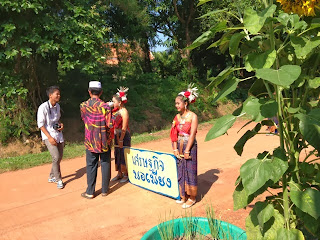“Buy You a Bed” and
“Butcher”
Two Stories
First story. Leaving school late one afternoon, I pass one
of my English colleagues sitting with other teachers, eating ice cream they
bought from the ice cream cart guy. They invite me to join them. After finishing the ice cream, they slice a
green mango and eat it dipped in a sweet and spicy mixture, of which Thai fish
sauce is a prominent ingredient (see link to recipe at the end of this
post). The dipping sauce leads to talk
about smelly foods from various countries and I try to tell them about blue
cheese, which I’m guessing they wouldn’t like. One of the women asks me about
buying something, but I don’t understand her.
My colleague’s translation comes out as “she want to buy you a bed.” Hmm, I think, that’s strange, but don’t
pursue it. A few minutes later, when
they are telling me I can get it at Tesco Lotus, I realize that they mean
“bread” – duh, of course. Thais routinely simplify consonant clusters in their
own language – for example, fish sauce, “naam bplaa” comes out as “naam
bpaa;” handbag, “gra pao” is “ga pao,”
and so on. The same simplifications are
made when they speak English, I should know that by now. I do know it, just can’t always remember to
scan their English sentences for missing consonants. Sigh.
Second story. My
co-teacher and I have been assigned to serve as judges in two English events at
an academic competition. The contestants
are elementary students (grades 1 - 6). In the morning we judge Impromptu
Speech, which in Thailand means a memorized speech; the impromptu aspect is
that the students must memorize several speeches and then draw lots to see
which one they will recite/perform. The afternoon competition is a spelling
bee.
For the spelling bee, there are three judges, my co-teacher,
me, and another teacher whom I will call Dee.
She speaks very good English, at a level of proficiency that is unusual
for elementary school teachers in Thailand. Most elementary teachers were not
English majors in college, and they must teach English on top of all the other
subjects, so it’s hard for them to improve their proficiency. Dee and I talk
about the spelling bee rules, which specify that “the foreigner” (i.e., native
speaker) must pronounce the words the students will spell – a rule that strikes
me as a bit unfair, since most students have learned English from a Thai
teacher and thus won’t be familiar with a native speaker’s pronunciation. But rules are rules.
The conversation shifts to foreigners who don’t speak Thai
and Thais who don’t speak English. I tell Dee it’s hard for me to practice
speaking Thai because when I try, the Thais either assume I’m speaking English
or don’t understand how I pronounce Thai. Either way, they answer me in
English, then continue talking with each other in Thai. She says, “They are afraid their English
won’t be good enough.” I say, but I’m
trying to speak Thai with them, they know how to speak Thai, it’s not about how
they speak English. She repeats that they are afraid their English isn’t good
enough. It strikes me that she hasn’t understood what I was saying. This is a trap I fall into – when speaking
with someone like her, whose English is easy to understand, I tend to forget
that just because it’s easy for me to understand them that doesn’t mean it’s
easy for them to understand me. Duh
again.
The word lists for the spelling bee are not published in
advance, but are made up by the judges.
My co-teacher and I make the list for students in grades 1, 2 and 3; Dee
makes the list for students in grades 4, 5, and 6. During the actual contest, I do my best to
pronounce each word and its definition distinctly, neither too fast nor too
slow, in the hope that my American accent won’t frighten the students too much.
In each round a few students can spell enough of the words to go on to the
final round. So we are at the final
round for grades 4, 5, and 6 and one of the words on the list is
“butcher.” The poor student who gets
this word is totally stumped and can’t even come up with the first letter. He’s
out of the running. Later, as we are
tidying up the room before leaving, Dee says she pronounces “butcher” as if the
first syllable rhymed with Dutch or much.
No, I say, it’s butcher. – Sigh
again. Note to self: In the future, remember to read all the words
to the person who made up the list before
the contest starts.
************
The link below will take you to a recipe for the dipping
sauce for green mangos:





















